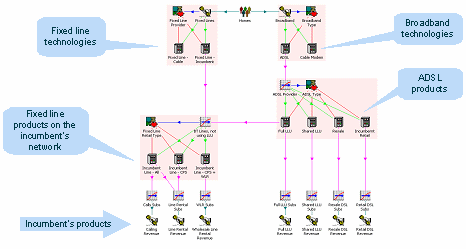25 current and prospective STEM clients attended the STEM User Group Meeting, held
on 20–21 September at Clare College in Cambridge, UK. The audience enjoyed guest
presentations from seven current users, as well as Analysys sessions on topical
models and new software features. For the first time, several sessions were split
into dual ‘tracks’, offering accelerated training for newcomers in parallel with
master classes and technical detail for experts.
ABeam Consulting
ADC Services
Alcatel
APEK
CEFRIEL
Ericsson
ITU-D
Juniper Networks
|
MoldTelecom
Motorola
QPO
Siemens
T-Mobile International
Telkom SA
Warwick Business School
Welsh Assembly Government
|
Delegates
Topical models and new software features
The event kicked off with a showcase model from Analysys, examining how STEM can
be used to structure a Market forecasting model for the full portfolio
of services offered by a tier-one operator. The model includes services such as
voice telephony and broadband, and examines churn effects from one operator to its
competition.

Marketing forecasting model showing segmentation of the market
Day two began with an interactive modelling session examining the business case
for WiMAX on the urban periphery. This topic has been covered recently
in a fairly detailed model examining the situation in France, which will be discussed
in our January 2007 newsletter.
Guest programme
Michael Chang from Ericsson presented a STEM model representing
Ericsson’s capacity growth solution, and then Oscar Gonzalez Soto, an independent
consultant working for the ITU, gave a talk on ITU-D activities on
planning for evolving networks.
Ruth Chatterton from Juniper Networks walked through a STEM model
examining Network consolidation over MPLS, and Frank Haupt from ADC
Services presented a Business case for distributed-antenna systems
which combined Excel with STEM.
Guido Freiling from T-Mobile International discussed some tricky
modelling issues concerning a Business case for SMS harmonisation and centralisation,
and then Ross Mackinnon from Alcatel showed us a STEM-based Business
model for GPON.
Finally, Manfred Illenberger from Siemens gave an interesting talk
on Building STEM into an automated sales presentation tool, linking STEM
results right through to PowerPoint.
Parallel tracks for newcomers and experts
Catering to the mix of experience levels present, three sessions were split into
two groups:
 A
fast-track training exercise for newcomers, running over two sessions, used an unconventional
example to focus on the essentials of business modelling. Steve Liput (Analysys)
led a captivating exercise using STEM to Model a budget airline business.
(This model is described in more detail in a
separate article in this newsletter.) A
fast-track training exercise for newcomers, running over two sessions, used an unconventional
example to focus on the essentials of business modelling. Steve Liput (Analysys)
led a captivating exercise using STEM to Model a budget airline business.
(This model is described in more detail in a
separate article in this newsletter.)
Steve Wyatt (Analysys) ran the final newcomer session, talking through the current
range of STEM licensing models, From desktop modelling to enterprise publishing.
|
|
Robin Bailey led the three technical master classes for existing STEM users.
What’s new in STEM 7.1 presented and demonstrated new features, focusing
on new snapshot charts, and tornado charts specifically for sensitivity analysis,
as well as a new break-even function.
The technical intrigue continued with a look at Undocumented features and new development
directions, which proved to be a surprise hit with the established STEM
community.
The final session on Streamlining interfaces with Excel and portability
took a close look at the Excel link generator (completed in STEM 7.1).
|